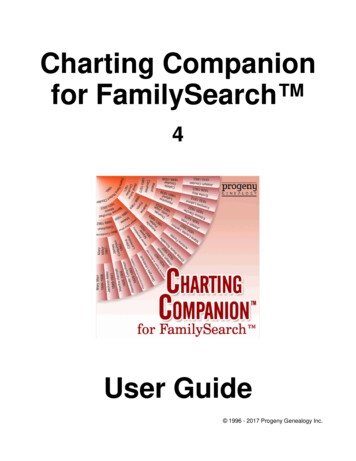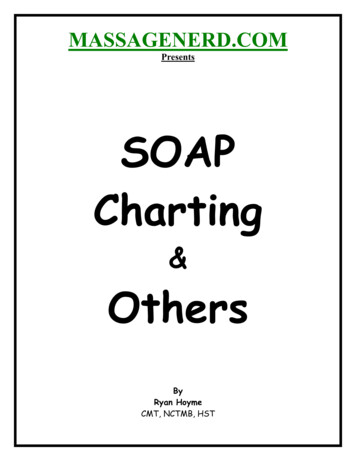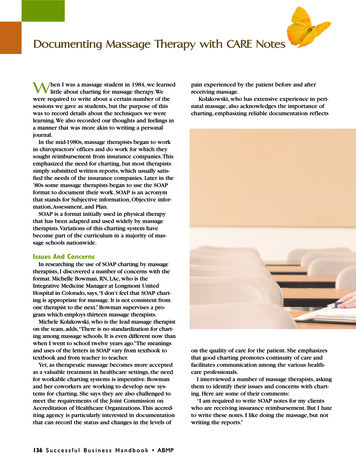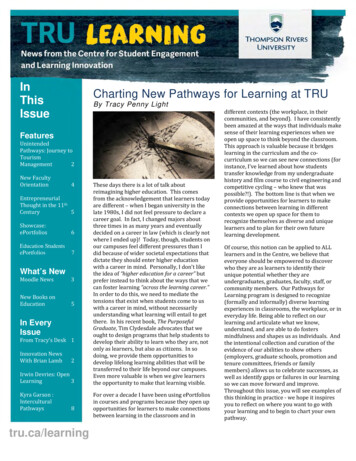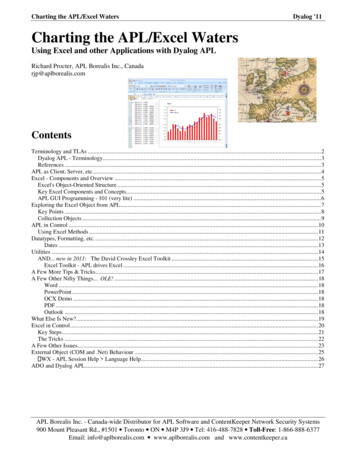
Transcription
CHARTING A COURSEto Help Secure your Future with Life InsuranceLIFE-1954 8/16 Approved ML 20-002613 Expiration 9/1/2021John Hancock Life Insurance Company (U.S.A.) – (John Hancock)John Hancock Life Insurance Company of New York – (John Hancock)
Some things shouldn’t be left to chance.You’ve made promises to the important people inyour life. To your family, it’s a financially secure future.To your children, a college education. If you have abusiness, you may have promised your employeescontinued employment. Certainly, you’ve promisedyourself a secure retirement. And perhaps mostimportantly, you’ve promised yourself to live a healthylife so you can enjoy time with your loved ones aslong as possible.Fortunately, there’s a way to help keep thosepromises — to protect the wealth you’ve accumulatedand the assets you’ll earn in the future — all whileearning rewards for living a healthy life.INSURANCE PRODUCTS:Not FDIC InsuredNot a DepositNot Bank GuaranteedMay Lose ValueNot Insured by Any Government Agency
Life InsuranceTHE SOLUTION TO HELP ADDRESS A WIDE RANGE OF NEEDSThe benefits and features of life insurance can keep your financialstrategy on course and help you meet significant goals, such as: Protecting your loved ones from financial hardship by providing assetand income protection from premature death. Building ways to supplement your income in a tax-advantaged vehicle. Creating a wealth transfer tool that helps ensure your legacy will passeffectively to the next generation. Providing solutions to keep closely held businesses operating by providingcash to transfer the business — as well as by providing important benefitsto employees. Supporting your pursuit of a longer, healthier life throughthe John Hancock Vitality Program.Take a look at the statistics below. They indicate that many U.S.households are not adequately insured, or may not have the rightinsurance coverage to help meet key financial goals that can ensuretheir financial security.The Facts of LifeMany U.S. households continue to be underinsured: Just under 60% of adults in the U.S. have life insurance coverage.¹ Nearly one-third (30%) of Americans believe they need morelife insurance.¹ 43% of Americans say they would feel a financial impact withinsix months if the primary wage-earner died.1Baby Boomers heading toward retirement: By 2029, all of the Baby Boomers (born between 1948-1964)will be 65 years old and over, and more than 20% of the total U.S.population will be over the age of 65.2 Over 40 percent of Americans are very or extremely concernedwith their ability to retire comfortably.11. LIMRA, 2015 Insurance Barometer Study.2. Colby, S. and Ortman, J., The Baby Boom Cohort in the United States: 2012 to 2060. U.S. Census Bureau, May 2014.1
ProtectionPROVIDING SECURITY FOR YOU ANDYOUR FAMILY — TODAY AND TOMORROWProtection from the UnexpectedThe fundamental purpose of a life insurance policy is to financially protect family membersfrom lost income due to the unexpected death of a primary income earner.For instance, the life insurance death benefit can be used to pay off a mortgage, fund educationobligations, and replace lost salary to pay for ongoing household expenses, debts, and evenoutstanding tax bills. A key value of life insurance when it comes to family protection is thatit provides the death benefit in the form of cash, in a timely fashion. In fact, life insuranceprovides protection exactly when it is needed, regardless of market or economic conditions.How Does It Work?A life insurance policy can provide an immediate income tax-free death benefit to your heirsin the event of your premature death. With proper planning, they will receive the proceedsdirectly (without probate) on an income and estate tax-favored basis (under current law).3Long-Term Care CoverageAdding a long-term care rider to a permanent life insurance product can help protect your family,your hard-earned assets, and your future from the high costs of long-term care. There are additionalcosts associated with such a rider, and benefits are subject to exclusions and limitations.FACTS YOU SHOULD KNOW At least 70% of people over age 65 will require long-term care services at some point intheir lives.4 The national average for 24-hour home care or one year in a nursing home can run morethan 94,200 (or 258 a day) for a private room.5 65% of Baby Boomers expect they will need long-term care at some point in the future,especially as many have firsthand experience in helping with aging parents.63. Life insurance death benefit proceeds are generally excludable from the beneficiary’s gross income for income tax purposes. There are a fewexceptions such as when a life insurance policy has been transferred for valuable consideration.4. Source: U.S. Department of Health and Human Services, National Clearinghouse for Long-Term Care Information, www.longtermcare.gov,November 2014.5. John Hancock’s 2013 Cost of Care Survey, conducted by LifePlans, Inc., 2013.6. Source: John Hancock’s 2015 Consumer Survey; Understanding Consumer Attitudes and Awareness.2
Supplement IncomeGOING THE DISTANCE — GETTING YOUWHERE YOU WANT TO GOCash ValueIn addition to providing death benefit protection, a cash value life insurance policy is flexibleenough to meet a variety of needs during your lifetime such as: Supplemental retirement income Cash to start a business opportunity Additional business cash flow College fundingNot only can your policy’s cash value be accessed to provide future financial solutions, but cashvalue life insurance offers tax advantages that can include: Tax-deferred growth Tax-favored withdrawals Tax-free death benefitHow Does It Work?A portion of your premium payments on a permanent life insurance policy, such as universal life orvariable universal life, goes toward building potential cash value which may accumulate each year,tax-deferred. Once you have accumulated enough cash value, you can opt to use it to cover yourpremium payments. Or a portion of the cash value can be withdrawn in the event of an emergency,or to supplement retirement income (keeping in mind that the policy’s death benefit is reduced bythe amount of the withdrawal).7Another common way people access their cash value is by taking out a loan against their policy andpaying it back at a favorable interest rate (frequently a zero net rate, depending on your policy).7Note that while there is no obligation to repay the loan during life, the money owed,plus interest, will be deducted from the death benefit upon death.7. Loans and withdrawals will reduce the death benefit, cash surrender value, and may cause the policy to lapse. Lapse or surrender of a policy witha loan may cause the recognition of taxable income. Policies classified as modified endowment contracts may be subject to tax when a loan orwithdrawal is made. A federal tax penalty of 10% may also apply if the loan or withdrawal is taken prior to age 591/2. Cash value available forloans and withdrawals may be more or less than originally invested. Surrender charges may apply to withdrawals taken from the cash values of alife insurance policy. Please refer to the life insurance contract for details regarding the amount of the charges and when they apply. The net cashsurrender value will generally reflect the amount available, net of surrender charges, for withdrawal.3
BENEFITS OF CASH VALUE LIFE INSURANCE:Permanent or cash value life insurance is built to last a lifetime.The permanent policy can help: Replace income for your family in the event of premature death Cover the contributions provided by a non-earning spouse(caring for children/home, other domestic services) Repay debt obligations Plan for business succession or estate transfer in the event of premature death Provide an alternative and efficient savings plan Offer potential protection from the claims of creditorsConsiderationsOf course, there are several other income alternatives you may want to consider in addition to lifeinsurance. The following chart summarizes how life insurance compares with these other options.LIFEINSURANCETAXABLEINVESTMENTSQUALIFIED PLAN/TRADITIONAL IRAROTH IRAMUNICIPALBONDSTax-Favored WithdrawalsYesNoNoYesYesTax-Deferred AccumulationYesNoYesYesYesTax-Free Death BenefitYes8NoNoNoNoUnrestricted Accessand No PenaltiesNo9YesNoNoYesContribution LimitsNo10NoYesYesNoCost of Insurance ChargesYesNo11NoNoNoREASON8. Life insurance death benefit proceeds are generally excludable from the beneficiary’s gross income for income tax purposes. There are a few exceptionssuch as when a life insurance policy has been transferred for valuable consideration. Comments on taxation are based on John Hancock’s understandingof current tax law, which is subject to change. No legal, tax or accounting advice can be given by John Hancock, its agents, employees, or registeredrepresentatives. Prospective purchasers should consult their professional tax advisor for details.9. Withdrawal of policy values in excess of the owner’s investment in the contract can cause recognition of gain (to the extent of gain) for income taxpurposes. Furthermore, while an owner generally may borrow against a life insurance policy without immediate income tax consequences, a lapse orsurrender of a policy against which loans are outstanding may also cause the owner to recognize policy value in excess of basis (for income tax purposes).10. For every life insurance policy, there is a minimum premium at any given time, the payment of which is necessary to keep the policy in force. Premiumsmay be paid in excess of this amount, which may have the effect of reducing future necessary minimum payments. However, excessive advance fundingof a life insurance policy can result in the policy being treated as a modified endowment contract, which would be subject to significantly different taxtreatment than other life insurance policies.11. If the underlying investment is a deferred annuity, cost of insurance charges and/or withdrawal penalty may apply.4
Wealth TransferNAVIGATING YOUR FUTURE —MAKING THE MOST OF YOUR SUCCESSYou own a variety of assets and have accumulated wealth over the years. While your income maybe primarily generated from various sources, including pension plans, non-qualified deferredcompensation plans, and social security, you may intend on preserving certain other personal assetsfor your heirs. In some cases, you may be giving up higher returns to preserve wealth by continuallyrolling over low-yielding certificates of deposit (CDs), or by maintaining municipal bonds to benefitfrom the tax-free income they offer. Or you may be holding a deferred annuity to take advantage ofthe tax-deferred growth it can provide your heirs. Unfortunately, there are additional taxes at deathassociated with owning some of these assets. Ultimately, you may be transferring more of your wealthto the IRS than to heirs.The chart below illustrates taxation of certain assets at death, based on current tax law:MUNICIPALBONDSCERTIFICATESOF DEPOSITDEFERREDANNUITIESSPIA12TRUST-OWNEDLIFE INSURANCE13Income TaxNoNoYesNoNoEstate TaxYesYesYesNoNoYes, whenbeneficiaries aregrandchildrenYes, whenbeneficiaries aregrandchildrenYes, whenbeneficiaries aregrandchildrenNoNoGenerationSkipping TaxHow Does It Work?By using a maximization approach in your wealth transfer strategy — in which you immediately orsystematically replace a deferred annuity, municipal bond portfolio, or other low income-producingasset with more tax-efficient vehicles — you may be able to transfer more to heirs while maintainingor increasing your income.12. A SPIA is a Single Premium Immediate Annuity that provides an income stream for a chosen number of years based on a single deposit made to purchasethe annuity. The income stream from the annuity is calculated on a Life-Only No-Refund basis so that the income will last for the lives of the incomebeneficiaries and no principal balance will be remaining in the estate at death. When using a maximization approach, the SPIA beneficiary is assumed to beyou, or you and your spouse, if applicable; otherwise taxation may apply.13. Trusts should be drafted by an attorney familiar with such matters in order to take into account income and estate tax laws (including the generation-skippingtransfer tax). Failure to do so could result in adverse tax treatment.5
BENEFITS OF USING A MAXIMIZATION APPROACHA maximization approach offers several possible benefits: Reducing market and interest rate risk by exchanging the asset for a moretax-efficient one Reducing your taxable estate without giving up income or a legacy for heirs Transferring more to your heirs by leveraging the asset’s income with life insuranceConsiderations The maximization approach should be used with assets that you do not need for retirementincome. The leverage that the insurance may provide is available only if you are insurable. Different investment choices, including Single Premium Immediate Annuities (SPIA) andlife insurance policies, carry different risks, costs, and benefits that each investor mustmeasure based on specific goals and tolerance for risk.14Lifetime GivingA program of Lifetime Giving can be part of your wealth transfer strategy. It can help reduceestate taxes, avoid probate, and — when combined with life insurance — may also increasethe amount passed to your heirs.BENEFITS Lifetime giving can help reduce the size of the estate and hence any potential estate taxes. Lifetime gifting can protect gifted assets from creditors, avoid probate for gifted assets,and protect your family’s privacy.15 When gifts are used to purchase life insurance, lifetime giving may increase the amountof money left for heirs.14. The exchange of an asset for a SPIA may be a taxable event and/or sales charges may apply based on the type of investment being exchanged.In addition, if the life insurance is not owned by a properly drafted life insurance trust, it is possible that the life insurance proceeds will be partof the taxable estate.15. Assuming the proposed initial gift was not a fraudulent conveyance meant to inhibit creditors.6
Business PlanningHELPING BUSINESSES STAY ON COURSEIf you are a business owner, you can use life insurance to protect your business and provideimportant benefits to your employees. Without proper planning and funding, many small businessesfail to continue to the next generation.Key Person InsuranceAs a business owner, you may be concerned about protecting the business from the death of a keyemployee whose knowledge and contributions to the company are invaluable. The loss of a keyperson may result in not only a loss in sales, but also a potential loss of important contacts andgoodwill. Your company’s credit position may also be compromised.How Does It Work?You can protect your business from the loss of a key person by implementing a Key Person insuranceplan. Your business buys a life insurance policy on the life of the key employee, with the businessas the owner and the beneficiary of the policy. Your business will pay the entire premium and — atthe death of the employee — your business will receive the entire death benefit. This income taxfree death benefit may be used to replace lost profits, recruit and/or retain qualified replacements, orprotect your company’s credit position. The employee does not have any interest in the policy, nordoes his or her family typically receive any benefits from the policy when death occurs.PREMIUMSJOHN HANCOCKLIFE INSURANCE POLICYBUSINESSDEATH BENEFITEMPLOYEEWith Key Person life insurance, your business has death benefit protection in case of a sudden andunexpected death and is able to access the potential cash value of the life insurance policy for cashflow, retirement benefits, or for unanticipated expenses.7
Business Succession PlanningThe success of your business can depend on certain individuals. The death, disability, orretirement of such individuals can be potentially devastating if adequate planning is not inplace. Buy-Sell plans are agreements in which one party agrees to buy and another agreesto sell a business interest in those circumstances. They allow for an orderly transfer ofownership, and life insurance can be an ideal source of funding for these important methodsof succession planning. Life insurance proceeds provide the cash to fund the transfer of abusiness at death. Or prior to death, a cash value life insurance policy can be used as a partialfunding source to replace a key owner’s activities at his/her retirement or disability.BENEFITS Guarantees a buyer: A Buy-Sell plan provides a guaranteed buyer upon the death,disability, or retirement of a business owner. The remaining owners are protected againstthe sale of a significant interest in the company to an unknown third party. Creates liquidity: At the death of one of the owners, his or her family may need cashfor ordinary living expenses. The life insurance used to fund the Buy-Sell plan can helpprovide this liquidity, as well as any estate tax liability.Executive Bonus PlansIn today’s increasingly competitive environment, it is getting harder for businesses to find anexecutive benefit plan to attract, retain, and reward talented executives. What type of planis available that will reward your most productive employees in a way that is flexible, costeffective, and simple to administer?Two plans may be able to help: the Executive Bonus Plan and the Restricted EndorsementBonus Arrangement (REBA). Each of these plans is appealing to key employees, taxdeductible to employers, and simple to implement and administer. In addition, theREBA can provide a strong incentive for employees to stay with your company.BENEFITSFor the employer, both the Executive Bonus Plan and the REBA provide a tax-deductible,discriminatory benefit plan that is simple to implement and inexpensive to administer.The Executive Bonus Plan offers an immediate income-tax deduction of the full bonusamount; the REBA provides a tax deduction as the employee vests in the bonus.Additionally, the vesting schedule of the REBA creates a strong incentive for the executiveto stay with the company. For the executive, both plans offer affordable life insuranceprotection and potential supplemental retirement income.8
Innovative ProductsOFFERING SOLUTIONS TO MEET YOUR NEEDSLife Insurance that Supports Healthier LivingJohn Hancock’s whole new approach to life insuranceallows you to earn valuable rewards and discounts,including lower life insurance premiums, by engagingin healthy activities and habits. To this end, we have partnered with Vitality, the global leaderin integrating wellness benefits with life insurance products.Life insurance with the John Hancock Vitality Program can help you secure your financial futurewhile supporting your pursuit of a healthier, longer life. You’ll even get a free Fitbit device so youcan track your healthy activities and start earning Vitality Points. The more Vitality Points you earn,the higher your Vitality Status and the greater the rewards,16 including discounted cruises and hotelstays, as well as the opportunity to lower life insurance premiums.17We currently offer the John Hancock Vitality Program on many of our policies, and expect it to beavailable on most others in the future. We invite you to contact your John Hancock representativefor more details.A Life Insurance Product for Every NeedJohn Hancock offers a wide range of life insurance products that include both term and permanentpolicies, such as universal life, indexed universal life and variable universal life. You can also enhanceyour policy to better meet your needs by choosing from an array of optional riders and features,including the John Hancock Vitality Program.16. To participate in the John Hancock Vitality Program, you must elect the Healthy Engagement Rider. For each year you are eligible to participate in the JohnHancock Vitality Program, you have an opportunity to earn credits based on healthy actions you take. Every year, these activities result in Vitality Points, whichare used to determine a Vitality Status, which then determines the amount of credits applied to your policy’s cash value. These credits may lower your premiumor improve your cash value accumulation potential.17. Please consult your financial representative as to how premium savings may affect the policy you purchase. Paying a premium amount that differs from anoriginally illustrated amount could reduce the duration of your policy’s Death Benefit Protection feature or impact other features of your policy.9
Benefits of Permanent versus Term LifeWhile term insurance can cost significantly less than permanent insurance, there are other factorsyou should consider when deciding which type of policy is the right fit for your needs.The following are some factors to consider about permanent insurance: Permanent death benefit protection — Unlike term insurance, which lasts only for a set periodof time, permanent insurance provides permanent protection against economic loss. Cash value accumulation — A permanent policy has the potential to accumulate cash valueon a tax-deferred basis and may help you to recover premiums.18, 19 Tax-favored income — Cash withdrawals may be taken on a tax-free basis up to the policy’s costbasis. Loans can be taken on a tax-deferred basis. Flexibility — The permanent policy may be designed to provide the insured with the flexibilityto address changing needs.The following chart provides a quick overview of the features of permanent and term life insurance.FEATURES OF POLICYPERMANENTTERM20Death Benefit ProtectionYesYesCash Value AccumulationYesNoAcceleration of Death Benefit During Lifetimeto Cover Long-Term Care ExpensesYesNoFlexibility Based on Changing NeedsYesNoJohn Hancock Vitality Program*YesYes*Available on most products; please check with your John Hancock representative.18. Depending on the performance of the underlying investment accounts of a variable universal life policy and the interest crediting rate on auniversal life policy, the cash values available for loans and withdrawals may be worth more or less than the original investment amount.Additional premiums may be required to sustain the policy.19. Purchasing variable universal life (VUL) insurance involves investing in under lying investment accounts that correspond to your investmentobjectives and level of risk tolerance. The types of risks associated with investing in these accounts include potential market, portfolio, inflation,and international risk. The primary purpose of VUL is to provide lifetime protection against economic loss due to the death of the insured personVUL insurance products are long-term contracts and are sold by prospectus. For more information, please refer to the product prospectus.20. John Hancock Term is convertible to any fully underwritten single life permanent policy in the John Hancock portfolio for the lesser of thefirst six policy years or to age 70. In policy year seven through 10, the policy owner can convert to a product designated for conversion.10
Needs Analysis WorksheetHow much life insurance do you need?Life insurance is an important component of any financial plan. This quick and easy Needs Analysis Worksheetwill help determine how much insurance coverage is needed to help secure your financial future.ASSETSEXPENSES1. Spouse’s Annual Income9.x Number of Years Total Projected Income2. Cash and SavingsAnnual Living Expensesx Number of Years Total Projected Living Cost10. Annual Mortgage/Rent3. Investmentsx Number of Years4. Home Equity Total Projected Mortgage/Rent5. Retirement Income6. Existing Life Insurance11. Outstanding Debt (Car Loans,Credit Cards, Personal Loans, etc.)12. Annual Childcare Cost7. Otherx Number of Years8. Total Assets (add lines 1–7) Total Projected Childcare Cost13. College for Child One Child Two Child ThreeThis worksheet does not take into account Total Projected College Costinvestment growth or the time valueof money. This is just an approximate14. Funeral and Settlement Costsestimate. Please contact your financialadvisor to determine the amount of15. Total Expenses (9 –14)protection that is right for you.Difference (between line 8 and 15)Amount of Insurance Needed11
Notes12
Strength. Stability. John Hancock.John Hancock’s strong ratings, as judged by the major rating agencies,are a comprehensive measure of the company’s financial strength andstability. This is important because these financial ratings reflect the lifeinsurance company’s ability to pay claims in the future. With over 150years of experience, John Hancock offers clients a diverse range of financialprotection products and wealth management services through its extensivenetwork of employees, agents, and distribution partners.
All guarantees and benefits of the insurance policy are backed by the claims-paying ability of the issuing insurance company. Policyguarantees and benefits are not backed by the broker/dealer and/or insurance agency selling the policy, nor by any of their affiliates,and none of them makes any representations or guarantees regarding the claims-paying ability of the issuing insurance company.Guaranteed product features are dependent upon minimum premium requirements and the claims-paying ability of the issuer.This material does not constitute tax, legal or accounting advice and neither John Hancock nor any of its agents, employeesor registered representatives are in the business of offering such advice. It was not intended or written for use and cannot be used by anytaxpayer for the purpose of avoiding any IRS penalty. It was written to support the marketing of the transactions or topics it addresses.Comments on taxation are based on John Hancock’s understanding of current tax law, which is subject to change. Anyone interested inthese transactions or topics should seek advice based on his or her particular circumstances from independent professional advisors.Insurance policies and/or associated riders and features may not be available in all states. Some riders may have additional fees andexpenses associated with them. Refer to the product prospectus for additional information.Variable universal life insurance has annual fees and expenses associated with it in addition to life insurance related charges (whichdiffer with the product chosen), including surrender charges and investment management fees. Variable universal life insuranceproducts are long-term contracts and are sold by prospectus. They are subject to market risk due to the underlying sub-accounts, andare unsuitable as a short-term savings vehicle. The primary purpose of variable universal life insurance is to provide lifetime protectionagainst economic loss due to the death of the insured person. Cash values are not guaranteed if the client is invested in the investmentaccounts. There are risks associated with each investment option, and the policy may lose value.Please contact 1-800-827-4546 to obtain product and fund prospectuses (for New York, contact 1-877-391-3748, option 4). Theprospectuses contain complete details on investment objectives, risks, fees, charges and expenses as well as other informationabout the investment company. Please read the prospectuses carefully containing this and other information on the product andthe underlying portfolios and consider these factors carefully before investing.Vitality is the provider of the John Hancock Vitality Program in connection with your life insurance policy and Healthy Engagement Rider.Insurance products are issued by: John Hancock Life Insurance Company (U.S.A.), Boston, MA 02210 (not licensed in New York)and John Hancock Life Insurance Company of New York, Valhalla, NY 10595 and securities are offered through John HancockDistributors LLC through other broker/dealers that have a selling agreement with John Hancock Distributors LLC, 197 ClarendonStreet, Boston, MA 02117. 2016 John Hancock. All rights reserved.MLINY060916064
CHARTING A COURSE to Help Secure your Future with Life Insurance LIFE-1954 8/16 Approved ML 20-002613 Expiration 9/1/2021 John Hancock Life Insurance Company (U.S.A.) - (John Hancock) John Hancock Life Insurance Company of New York - (John Hancock)

